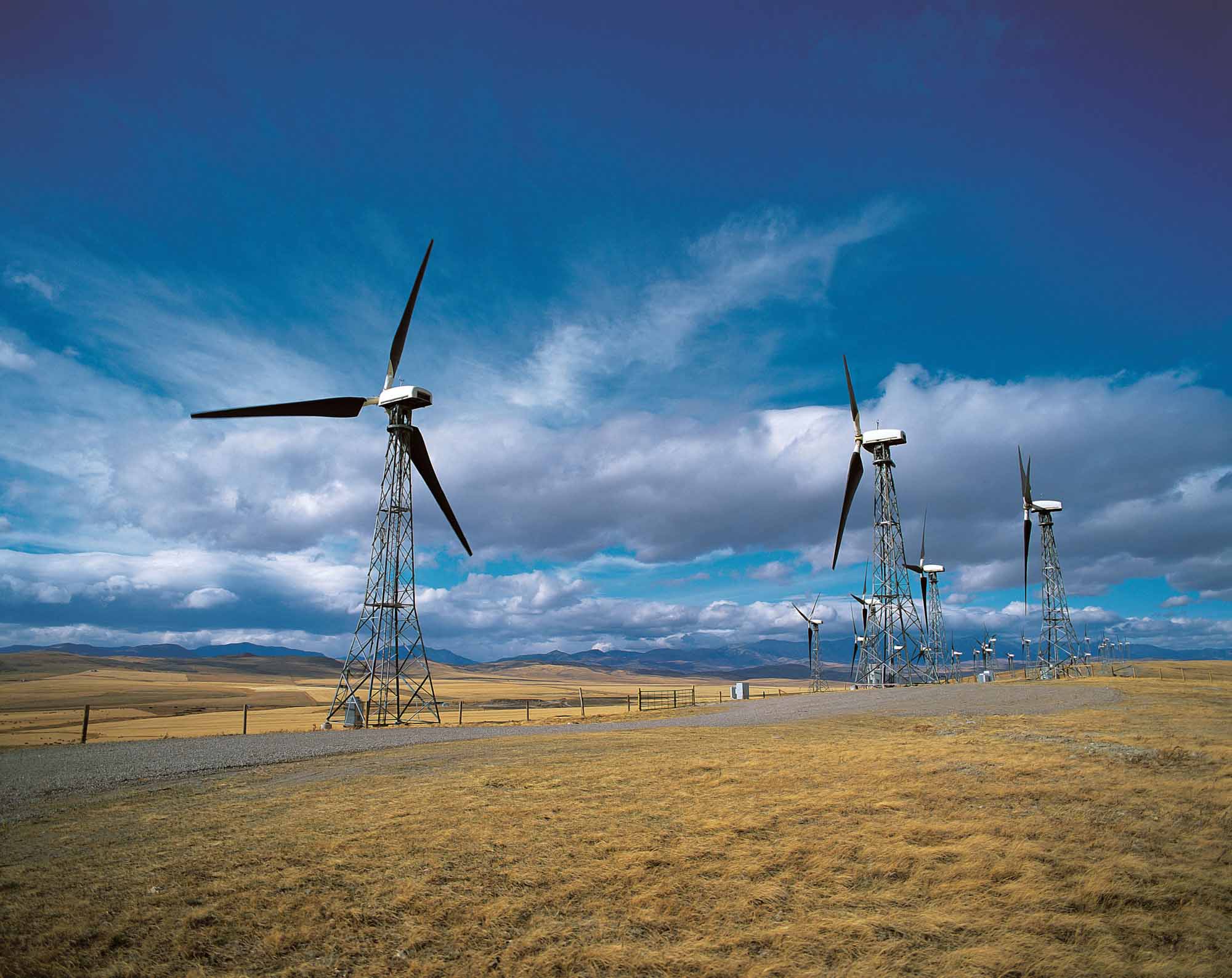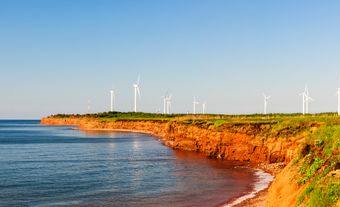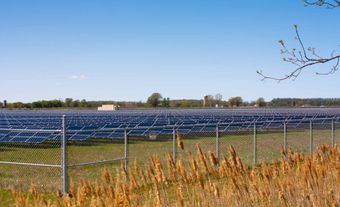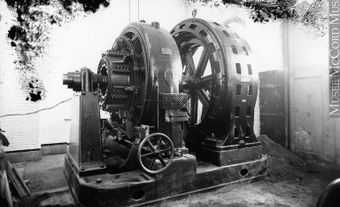Wind energy is energy obtained from moving air. The motion results from the heating and cooling of the Earth; thus, wind energy is an indirect form of solar energy. It is normally turned into useful energy by the action of wind currents on moving surfaces such as the sails of a ship or the blades of a windmill. Wind energy is one of the oldest forms of energy used to supplement human muscle.

Background
Windmills and other spinning wind-energy devices – more accurately known as wind turbines – were used for grinding grain by the 7th century AD and were in wide use for this purpose and for pumping water by the Middle Ages; they were brought by the French to Canada in the 17th century and were commonly used for grinding grain. Ships have used sails for at least 3,000-4,000 years. Before the advent of rural electrification systems, wind turbines were also used to generate electricity on farms in North America, notably on the Canadian prairies. (See also Electric Power.)
The advantage of wind-energy systems is that they tap an inexhaustible energy source that has no competing uses; hence, there is no fuel cost. (See also Natural Resources in Canada.) The disadvantage is that wind conditions are unpredictable: they are subject to gusting and becalming, to daily and seasonal variations in strength, and to interactions with local topographic features. To meet a continuous demand such as a community’s lighting and heating, a wind-energy system must either be integrated with other energy sources or include a means of storing energy for use during calm periods. If the demand is not continuous (e.g., in agricultural water systems or unscheduled water transportation) wind energy can be employed very usefully.
The reawakening of interest in wind-energy conversion systems is the result of increasing energy demands and the relatively high costs of conventional energy sources. New wind-energy conversion equipment uses advanced aerodynamic features, modern structural design and new materials. The revival encompasses not only land-based systems but also commercial marine applications. New sail configurations have been devised to improve ship performance dramatically. However, the greatest effort has been focused on land-based generation of electric power using high-speed wind turbines.
Did you know?
In 2022, wind accounted for 6.1 per cent of Canada’s electricity production.
Applications
The areas of Canada with the prime potential for wind-energy applications are those where there is a coincidence of good wind-energy sites with nearby energy users. Such a combination minimizes the size of wind turbine required for a given output, the capital cost of the energy-transmission system required and the associated transmission losses. Areas of maximum wind energy availability in Canada tend to occur on the East and West Coasts, in a portion of northern Manitoba and in the southern portions of Alberta and Saskatchewan.
The greatest potential appears to be for electric-power generation to serve nearby population centres and rural communities. Where circumstances permit, the electricity would be fed into existing electrical distribution grids. This is the type of system that utilities such as Newfoundland and Labrador Hydro and Saskatchewan Power Corp are using experimentally. Fairly large-scale water-pumping applications may also be feasible in Alberta and Saskatchewan for irrigation. Special cases where wind energy appears to be particularly attractive occur in very isolated areas that have high conventional energy costs, e.g., some northern communities. In these cases, wind-turbine generators will almost certainly be combined with, for example, power from internal-combustion engines to provide a continuous and reliable supply. The alternative, using wind-turbine generators to charge batteries, appears to be too costly for large-scale plants. Additional opportunities for Canadian industry may arise from the export of wind-energy systems to other countries.
The most recent developments in wind-energy applications relate to the generation of electrical power. This use arises from the prior existence in many areas of electrical-distribution grids, as well as the general convenience and flexibility of electrical power. Direct uses of mechanical energy produced by wind turbines are primarily for water pumping. At present, wind-turbine-driven water pumps are typically small machines, used mostly for watering stock. In the future, larger machines may be produced for irrigation pumping and other applications. One possibility is pumped-storage systems in which water pumped from a low elevation to a reservoir at a higher level is allowed to flow back through a hydroelectric turbine.
Turbine Characteristics

Different turbine characteristics are required for each type of application. Most electrical-power generators, or alternators, tend to require a relatively high speed of rotation. Consequently, turbines that run fairly fast, with the tips of the rotor moving 3-10 times the wind speed, are generally preferable to low-speed turbines because less gearing is required between the shaft of the wind turbine and the armature of the generator. A relatively low running speed is generally favoured for wind turbines that are directly coupled to water pumps or other mechanical loads. A striking feature of wind turbines intended for high-speed operation is the low rotor solidity, that is, the very small blade area in proportion to the turbine rotor's total projected area. Low-speed turbines feature a high solidity (either a small number of relatively broad blades or a large number of narrower ones).
All modern high-speed turbines and most of the low-speed units incorporate blades designed on airfoil principles. Some inefficient low-speed machines depend on a drag effect, as does a square-rigged sailing ship. The foregoing remarks apply equally to wind turbines that are arranged with horizontal or vertical axes of rotation.
Typical horizontal-axis high-speed wind turbines have either two or three blades and resemble aircraft propellors. The blades of these machines are commonly arranged to vary in pitch automatically to optimize performance under conditions of varying wind speed. The most common high-speed vertical-axis turbine is the Darrieus rotor, named for its inventor. This machine is also known as an "egg beater" because of its characteristic appearance.

The most common form of low-speed machine is the horizontal axis, multibladed form often found on farms. The turbine is usually connected, via a crank, to a reciprocating water pump. A related design is the multibladed "bicycle-wheel" turbine, an example of a relatively low-speed turbine used for electrical-power generation. A simple vertical-axis design, often used for water pumping, is the split-cylinder configuration known as the Savonius rotor, after its originator. In this turbine each of the 2 or 3 rotor blades consists of a semicylinder offset radially from the axis of rotation. The design relies, in part, on a drag effect for its operation. It is not, therefore, a particularly efficient configuration, but is relatively simple to make.

General advantages of wind turbines are the complete absence of air pollution and a high energy-conversion efficiency. Well-designed wind turbines can recover up to 60-80 per cent of the kinetic energy from the flow passing through their rotors. However, the low energy density available in the wind typically restricts output to a range 0.1 to 0.8 kW/m2 (kilowatts per square metre) of the rotor's projected area. The result is a large machine size in relation to output; for example, in a machine rated at 5 MW (megawatts) (MW=106 W), a high output for a single wind turbine, the rotor diameter can be as large as 100 m. This size problem results in the use of clustered machines, known as wind farms, to extract large power outputs from individual sites. Another problem with wind-energy systems is the variability of wind strength, which leads to substantial fluctuations in power since output is roughly proportional to the cube of the wind speed. Furthermore, all wind-energy conversion devices incur additional costs because they must be capable of withstanding storms.
Wind Energy in Canada
As of 2020, the Canadian Renewable Energy Association promotes the use of wind energy, solar energy and energy storage solutions in Canada. The National Research Council of Canada (NRC) has promoted research into wind energy since the 1960s. In the 1980s Canada built the world's largest Darrieus-type wind turbine at Cap-Chat on the Gaspé Peninsula. Project Éole, a joint Hydro-Quebec and NRC enterprise, erected a turbine 110 m tall at a cost of $35 million. A predecessor of Éole was the 230 kW wind turbine erected in the Îles de la Madeleine, Quebec. It was built by Indal Technologies Inc, Mississauga, Ontario, which subsequently developed a 500 kW commercial variant of this experimental machine. It reached the multi-megawatt scale - 4MW - but was not operated very long because of the instability of the blades. Windmill projects in Canada, the United States and the United Kingdom continue to explore the potential of wind energy.

 Share on Facebook
Share on Facebook Share on X
Share on X Share by Email
Share by Email Share on Google Classroom
Share on Google Classroom




